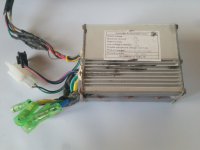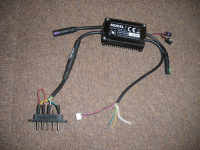ChrisOfBristol said:
You've made some good points about this, but since I have the display it isn't a problem.
That's good. Including details like that when you first post questions makes it easier for us to give you relevant and useful help without wasting your time.

I've done that, but unfortunately it's potted (it's encased in a lump of epoxy resin or similar).
That's uncommon, but can be defeated. There are a few threads about dissolving various potting compounds, but if it is silicone rather than epoxy you'll probably have to pick it out (dental tools work well for this, but take a lot of time and patience). Most of the solvents won't harm the electronics or wiring, but some do damage wiring insulation so wiring may have to be replaced afterward (probbably not). It can take some time (days, sometimes weeks) for the solvents to work, however.
If you do have to get a new controller, I recommend getting a complete kit that is already setup to work together (not all "kits" are even wired up to connect out of the box and have to be hacked to connect all the pieces!). If you already have a motor you want to use, or other parts, but get a new controller and display, it's pretty likely you'll have to change connectors on one or another part of the system to hook it all up.
What power level are you looking for? (meaning, what do you want the bike to do, specifically?)
As a motorcyclist I am perfectly capable of using a throttle and would far prefer it. I have ridden a friend's PAS bike, I was doing a U-turn and was going a bit too slowly, so pedalled a little - the power came in and nearly threw me off...
Sounds like that was one of the (many) poor PAS implementations. Unfortunately there are a lot of them.
On my SB Cruiser, using the Cycle Analyst v3 as a mediator between the control inputs and the motor controllers, I'm able to completely control the power via PAS so that doesn't happen. I also have a throttle, but because of intermittent hand problems I prefer to control it via pedalling (as a lifetime bicycle rider it's natural to me). (I have also built setups with throttles only, including with a separate throttle for each motor wheel, and they work fine too).
With poor PAS implementations, which are very common on cheap OEM bikes and cheap kits, a throttle would be "safer" for the typical rider than the simple on/off control (often with serious delay in response time) that the poor PAS implentations give.
Some have multiple power levels set thru the display or a control on the handlebars, but still use the PAS only to turn full power on once pedals have rotated a certain amount and turn it off once they stop moving long enough. Those are better than the ones with no level control at all, but are no safer because they still give no control over power via pedalling, which is NOT how a bicycle works, so anyone used to riding one will not be able to control it instinctively, and may never be able to fully control the system in unexpected situations.
Some PAS implementations only require pedalling to activate the system, but control is done via throttle. THat's usually just a nod to legal requirements.
Others have complete power control via PAS, either via cadence or torque or a combination of both. (this is how the CAv3 can work)
Unforunately many (most?) of the systems that don't come with a throttle already are not capable of using one. (not without creating intermediate hardware, and even then will not behave like a controller that has direct throttle control built in). As noted previously, if it does have a proportional PAS control, rather than on/off control only, then you could use a Nano or similar to read the throttle voltage, and then output the (probably cadence) signal needed by the PAS input to use this to control motor power / speed (whichever it does).
With the CAv3, there *are* certain limitations to it's operation, some of which are intended as safety features but unfortunatley aren't optional. I started a thread for Nano Tidbits projects to work around some of these, but have yet to get back to it to finish anything due to life interruptions. But it works fine for most applications, once the user has tuned it to their specific needs and system. It won't turn a throttle signal into a PAS signal, but it does do the opposite.
 I have a Momentum Electric Model-T Hall effect sensor brushless wheel and controller from a written-off electrice bicycle. The controller has 8Fun stamped on the back. I can see which are the cables for the motor and display and there are two paralleled plugs with red and black wires which I think are for lights.
I have a Momentum Electric Model-T Hall effect sensor brushless wheel and controller from a written-off electrice bicycle. The controller has 8Fun stamped on the back. I can see which are the cables for the motor and display and there are two paralleled plugs with red and black wires which I think are for lights.



